We get lots of questions from people regarding the bikes we’re riding and in particular our combination of panniers with more new-school Revelate Designs bikepacking kit. Here’s a breakdown of how we’re both set up for our Alaska to Patagonia tour, including a full gear list from each of us.
(Note, Jan 2019) Our Andes Gear List is more up to date than the list on this page, with a greater emphasis on weight savings and cold weather equipment.
Hana
Surly Ogre (29er), which was purchased as a standard build (second hand) that we made a few customisations to:
• Carbon seat post and Brooks B17 Standard saddle;
• Watson Cycles Revelation titanium handlebar with Ergon GP1 grips;
• 170mm cranks with 22, 32, 42 chainrings and 11-36 cassette;
• Son dynamo front hub paired to The Plug III USB charger (mounted on steerer) with Stans ZTR Arch EX rim;
• Tubus Cosmo stainless steel rear rack;
• Salsa Anything Cage HDs mounted on fork.
Mark
Surly Ogre (29er), purchased as a frame only from Universal Cycles in Portland, WA. The build was done by Web Cyclery in Bend, OR.
• Thomson Elite stem and seat post with Brooks B17 Narrow saddle;
• Watson Cycles Revelation titanium handlebar with Ergon GP1 grips,
• 175mm cranks with 22, 32, 42 chainrings and 11-36 cassette (no big ring since Quito);
• Stans ZTR Arch EX rims with Stans Neo hubs;
• Tubus Cosmo stainless steel rear rack;
• Salsa Anything Cage HDs mounted on fork
• We’re both using Shimano’s M785 Trail Pedal, which is great for extra foot support, without being too big.
Tyres
From Deadhorse, AK to San Diego we both ran 2.35 – 2.4 inch tyres, except for the long highway section from Whitehorse to Banff, where we swapped to 1.5 inch slicks. The Great Divide riding surfaces are very variable, and we’ve concluded that if we were riding it again it we certainly wouldn’t want to run skinnier tyres. 2.35 inch has given enough volume to soften the bumps and allow us to carry speed over rougher sections of road, without creating the drag that a bigger volume tyre would have.
For the Baja Divide’s rough and sometimes sandy surfaces we used 3 inch tyres on the front and a 2.4 on the back, and have done ever since, through Mexico, Central America and South America.
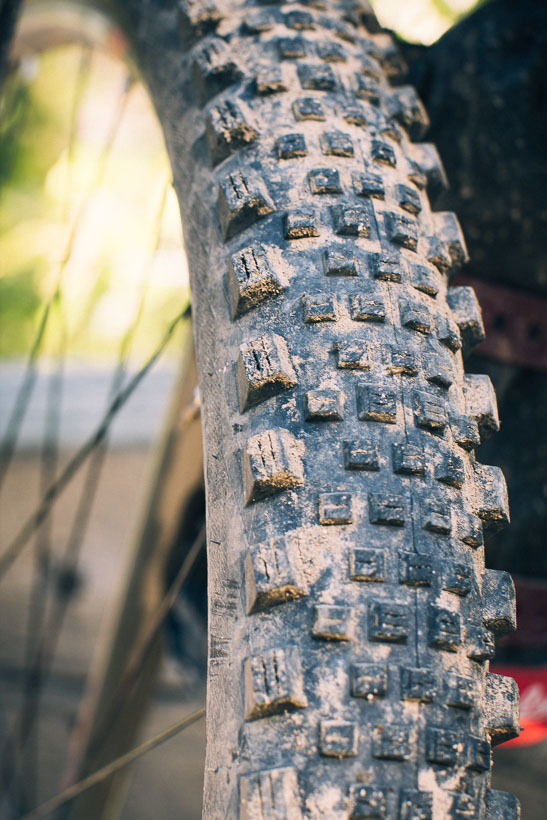
How we carry the load
Our carrying capacity is comprised of small rear panniers each and Revelate Designs bike packing kit: the handlebar holds the Harness and Salty Roll which I use to carry my sleeping bag and some spare clothing. Hana’s contains our MSR Hubba Hubba tent. Integrated with the Harness are a pair of Mountain Feedbags. We carry water bottles, food and/or our bear spray cans in these – a great way to keep your bottle handy and easier than reaching down to the frame triangle. On the front of the Salty Roll we each mount a Pocket (now replaced with Egress)– for small items that need to be kept handy during the day.
On the frame we each have the Ranger frame bag. These have a velcro divider in the centre so you can split the bag into two compartments.
Along the top tube we have the Mag Tank; for on-the-ride snacks (we don’t tend to stop for snacking), and the Jerrycan which is ideal for tools and chain lube.
Under the seat I sometimes use the Terrapin harness and drybag (when we want to travel lighter) which I love for the fact that the fully waterproof bag can be removed from the harness and quickly thrown in the tent. Hana uses the Pika (as small bikes have less clearance).
Hana has relatively small Revelate Nano panniers, so she is uses a dry bag on the rack for her sleeping bag and food-overflow.
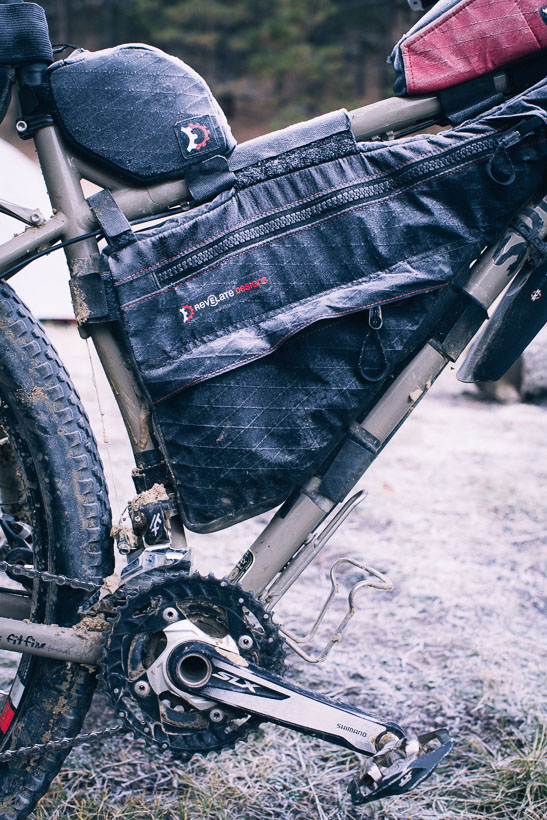
Gear Lists
This is our ‘base’ long-distance touring gear. I.e. used for the majority of the ride from Deadhorse, AK to San Diego, CA. It proved to be a not-too-heavy load for the long climbs and rough and sometimes steep riding of the Great Divide. For the Baja Divide we cut the load right back and droped the laptop/hard drives, stove and extra clothes, before resuming a more normal load for the journey south through Mexico and Central America. Having a combination of panniers and Revelate bags gives us the flexibility to adapt our set up for the climate and to lighten up if need be for long technical/mountainous sections of the ride. Updated Andes Gear List (Oct 2018).
(*) denotes that the item is swapped seasonally – see list at bottom for specific winter gear.
Mark
Body
• Short sleeve full zip cycling jersey
• Short sleeve merino top
• Long sleeve merino hoodie*
• Windproof cycling jacket: A very old Mountain Hardwear Transition
• Waterproof breathable rain shell: Mountain Hardwear Plasmic Ion (inexpensive)
• Down jacket: Rab Microlight Alpine*
• Arm warmers: Pearl Izumi
Legs
• Underwear x1
• Long pants: Outdoor Research Ferrosi (very light, but will swap for shorts after USA)
• Biking/hiking shorts: Kathmandu Aklo (light, vented, fast drying and hardwearing – love them)
• Knee/thigh warmers: Pearl Izumi
• 3/4 waterproof overpants: Endura Superlite
• Padded cycling short liners x 2
Head/Hands/Feet
• Long finger MTB gloves
• Light thermal liner gloves
• Dishwashing gloves (used as over-glove in cold rain)*
• Socks x2 short
• Outdoor Research soft shell beanie* (an amazing hat that works well under a helmet in cold rain and freezing winds)
• Neck gaiter, merino*
• Buff (great for keeping ears/face warm on cold mornings)
• Cap (for apres-bike wear)
• Bike shoes: Shimano XM7 (best MTB adventure shoes I have ever had)
Tech
• Macbook Air 13 inch + Thule Gauntlet sleeve
• Hard drive 4TB x 2 (for photos video captured during ride – one drive is dedicated backup)
• Hard drive 2TB x 2 (work files, plus most of my photographic library)
• Power bank: Battery Box (16,500 mAh – can run laptop for several hours)
• iPod touch + in-ear headphones
• Phone: Samsung S5 (used for navigation with Backcountry Navigator and Osmand apps)
• Bryton Rider 100 GPS cycle speedometer
Accessories/Misc
• Helmet
• Sunglasses (a dark pair and a pair with changeable amber lenses for grey weather/forest riding)
• Brooks waterproof saddle cover
• Revelate designs wallet
• Passport
• Headtorch: Led Lenser SEO5 (can be set to stay on red LED only – great for night photography)
• Sunscreen & lip salve
• Biomaxa Chamois Cream
• Various lightweight drybags
• 750ml bicycle water bottle
• 2.0 litre Camelbak bladder (without hose)
• 2.0 litre Platypus bladder (extra water capacity for dry sections)
• Bear spray (for North America north of southern New Mexico)
• Bear bell (for North America north of southern New Mexico)
• Ursack S29.3 All White bear bag (for North America north of southern New Mexico)
Sleeping/Camping
• Sleeping bag: Kathmandu Pathfinder*
• Silk liner
• Sleeping mat: Thermarest Neo Air XLite (packs up tiny)
• Camp seat: Thermarest Compack Chair Kit (a light luxury that I won’t carry past end of USA)
• Two 1.5m x .6m sections of silver coated bubble foam (protecting tent floor/comfort sitting at picnic tables)
• Spork
• 500ml plastic bowl (all eating/drinking duties)
• Toiletries (razor, shaving oil, toothbrush, toothpaste, soap scrap)
• Microtowel, small
• Pocket knife
• Homemade light nylon food bag
Photography
• Sony A7RII Camera body
• Metabones Sony/Canon adapter
• Canon 16-35mm f2.8L
• Canon 50mm f1.2L
• Canon 70-200mm f4L IS
• Cable release
• Cleaning kit (Lenspen, microfibre cloth, lens fluid, sensor cleaning swabs + fluid)
• 5 spare batteries (Sony batteries do not last long)
• 64 GB SanDisk SD card (x1)
• 32 GB SanDisk SD card (x2)
• Lee filter holder
• Circular polariser
• .6 and .9 Lee soft grad filters + Adorama Slinger filter pouch (holds all filters)
• 3-stop ND filter
• Sirui T-024X carbon fibre tripod + ball head
• All camera gear except filters carried in Lowepro Flipside Sport 10L AW pack (an old model now)
Bike tools/repairs
• Tubes x2
• Biomaxa chain lube
• Patch kit
• Topeak Multi-tool with chainbreaker
• Leatherman Juice S2 (scissors and pliers)
• Torx tool for rotor screws
• Very small adjustable wrench
• 2 x spare rack/water bottle screws and nylock nuts
• 1 x spare seat post binder bolt
• Small section of 10 speed chain (for serious chain breakages)
• 2 x 10 speed chain ‘quicklinks’
• 1 x spare brake cable
• 2 x spare shifter cables
• Small blob of grease in plastic bag
• Stein Mini Cassette Lock Tool (for removing cassette without usual tools)
• Tyre boots (cut from old road tubeless tyres)
• Tubeless tyre plugs (use Leatherman to insert)
• Spare disc brake pads (x2 pairs)
• Spare spokes (x2)
• Cable end caps (x2)
• Assorted cable ties
• Length of duct tape (wrapped around pump)
Cold weather gear
• Sleeping bag: Sea to Summit TSII Dri-Down
• Down jacket: Kathmandu XT DriFill
• Fleece jacket: Outdoor Research Radiant Hybrid Hoodie (best fleece ever!)
• Waterproof/breathable ski gloves (cheap ones)
• Long johns
• Neoprene shoe covers (1mm-thick)
• Long socks x1 (we prefer a knee warmer/long sock combo over full-length leg warmers for easier temperature regulation and flexibility)
Hana
Body
• Short sleeve full zip cycling jersey* (will switch to sleeveless for warmer weather)
• Short sleeve merino tee
• Long sleeve merino
• Arm warmers: homemade
• Long sleeve shirt* (to keep off sun and mosquitos)
• Windproof jacket
• Waterproof jacket: Arcteryx Beta LT Gore-Tex (has leaked through the front zip since I bought it – am sending it back and replacing with Kathmandu Zeolite for Mexico south)
• Down jacket: Kathmandu XT Ultralight DriFill*
• Sport bra
• Bra
• Merino singlet
Legs
• Merino underwear x 2
• Long cotton/nylon pants*
• Shorts
• Padded Bike shorts x 2: Ground Effect Sirens, and Louis Garneau
• Knee/thigh warmers
• 3/4 waterproof overtrousers: Vaude (not 100% waterproof but better than nothing)
Head/Hands/Feet
• Short MTB gloves
• Long MTB gloves
• Light waterproof bike gloves: Sealskinz
• Socks x 3 short*
• Merino beanie
• Neck gaiter, lightweight
• Headband
• Cap
• Bike shoes: Pearl Izumi X-Alp Enduro (uppers started separating from the sole after about four months)
Tech
• Camera: Sony RX100 III, and spare battery
• Hard drive 500GB
• USB flash drive 64GB
• Power adaptor: Belkin
• Power bank: Plox 6000
• ipod Nano
• Phone: Samsung S5
• Kindle
• iPad Air
• Go Pro Hero 3 Silver
• Cycle speedometer: Cateye Micro wireless
• Headtorch: Black Diamond Spot
• Rear light, helmet mounted
Accessories/Misc
• Helmet: Catlike Leaf
• Helmet cover: homemade
• Sunvisor
• Sunglasses x 2, and case
• Backpack: Sea to Summit Ultra-sil
• Saddle cover: homemade
• Revelate Designs wallet
• Passport x 2
• Various lightweight drybags
• Water bottle: 700ml Camelback
• Water bladder x 2: 2.0 litre Platypus
• Pocket knife
• Homemade light nylon food bag
• Bear spray (for North America north of southern New Mexico)
• Bear bell (for North America north of southern New Mexico)
• Ursack S29.3 All White bear bag (for North America north of southern New Mexico)
Sleeping/Camping
• Sleeping bag: Kathmandu Pathfinder*
• Silk liner
• Sleeping mat: Exped UL7, and Schnozzle pump bag
• Drybags: Sea to Summit ultra-sil compression 10 litre x 2 (for clothes and sleeping bag)
• Camp seat: Thermarest Trekker (old model)
• Silver Insulation bubble foam for seat pad
• Spork
• 500ml plastic bowl (all eating/drinking duties)
• Toiletries: toothbrush, toothpaste, Chapstick, earplugs, mooncup, Dr Bronners, small pack wet wipes
• Microtowel, small
Bike tools/repairs
• Spare tyre
• Tubes x 2
• Bike pump: Lezyne Micro floor drive (the best pump ever!)
• Bike lock, lightweight cable (to stop opportunists)
• Biomaxa chain lube
• Patch kit
Cold weather gear
• Sleeping bag: Marmot Xenon
• Down jacket: Kathmandu XT DriFill
• Microfleece zip thermal
• Fleece jacket with hood
• Insulated ski gloves with fleece liners
• Leggings
• Neoprene shoes covers (1mm)
• Waterproof socks
• Long socks x 2
• Extra neck gaiter
Shared gear
Cooking/Camping/Comms/Nav
• 750ml MSR fuel bottle + Whisperlite Internationale burner
• 500ml Sigg fuel bottle
• GSI Halulite 2 litre cooking pot
• Small pot scrub pad
• Small plastic bowl with lid for mixing/storing food
• Stove repair kit (o-rings, pricker etc)
• Pot grip
• Stove lighter (flint)
• Tent: MSR Hubba Hubba NX, and footprint
• luminAID (solar charged inflatable light – brilliant for lighting cooking area and tent)
• Steripen Ultra (USB rechargeable)
• First aid kit: painkillers, antibiotic ointment, bandaids, steristrips, suture kit, non-stick dressings, tape, antihistamines, prescription antibiotics, gastro-soothe
• Repair kit: needles, thread, patches and glue for mat and tent, tent pole repair sleeve
• 15m x 3mm cord for hanging food/clothes line
• InReach SE (used for updating our location each night, communication via satellite text/email, and emergency locator beacon)
• Printed maps (for overview/backup – we use Backcountry Nav app for detailed route finding*
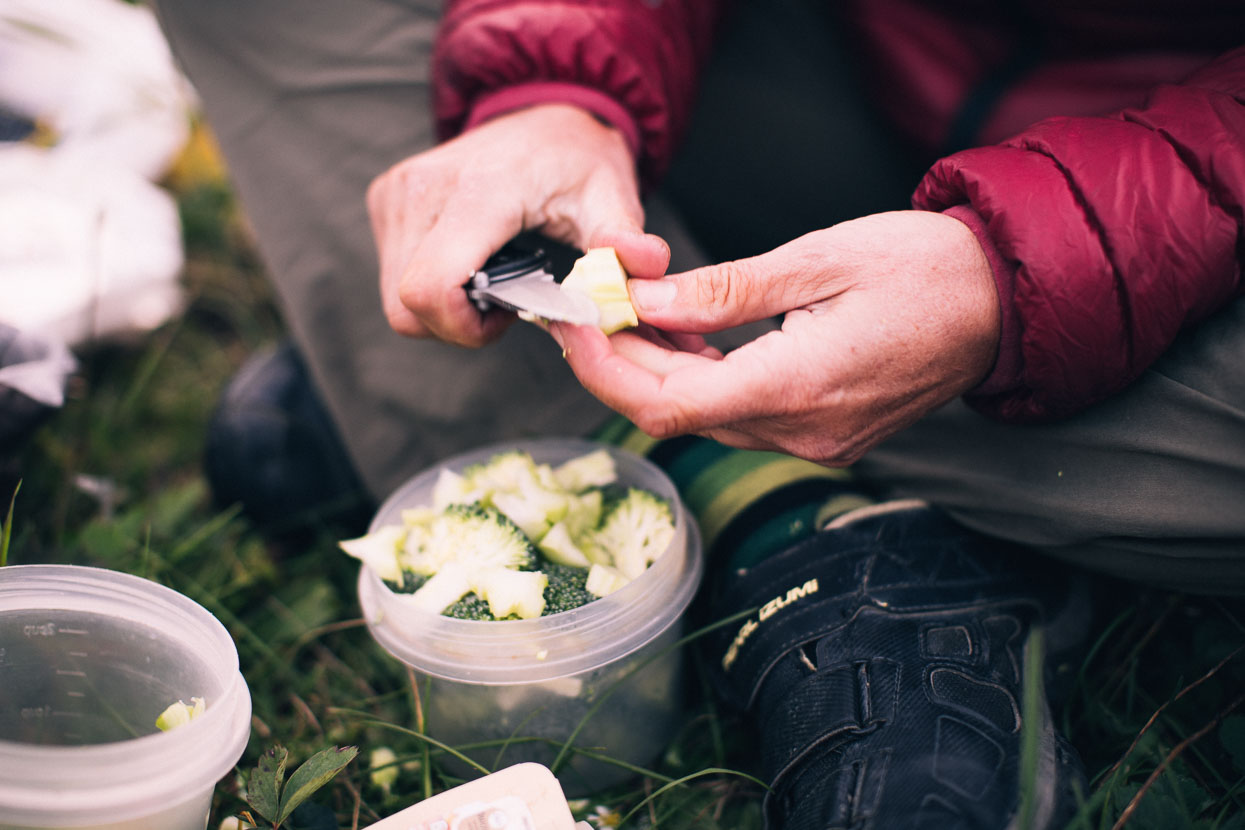
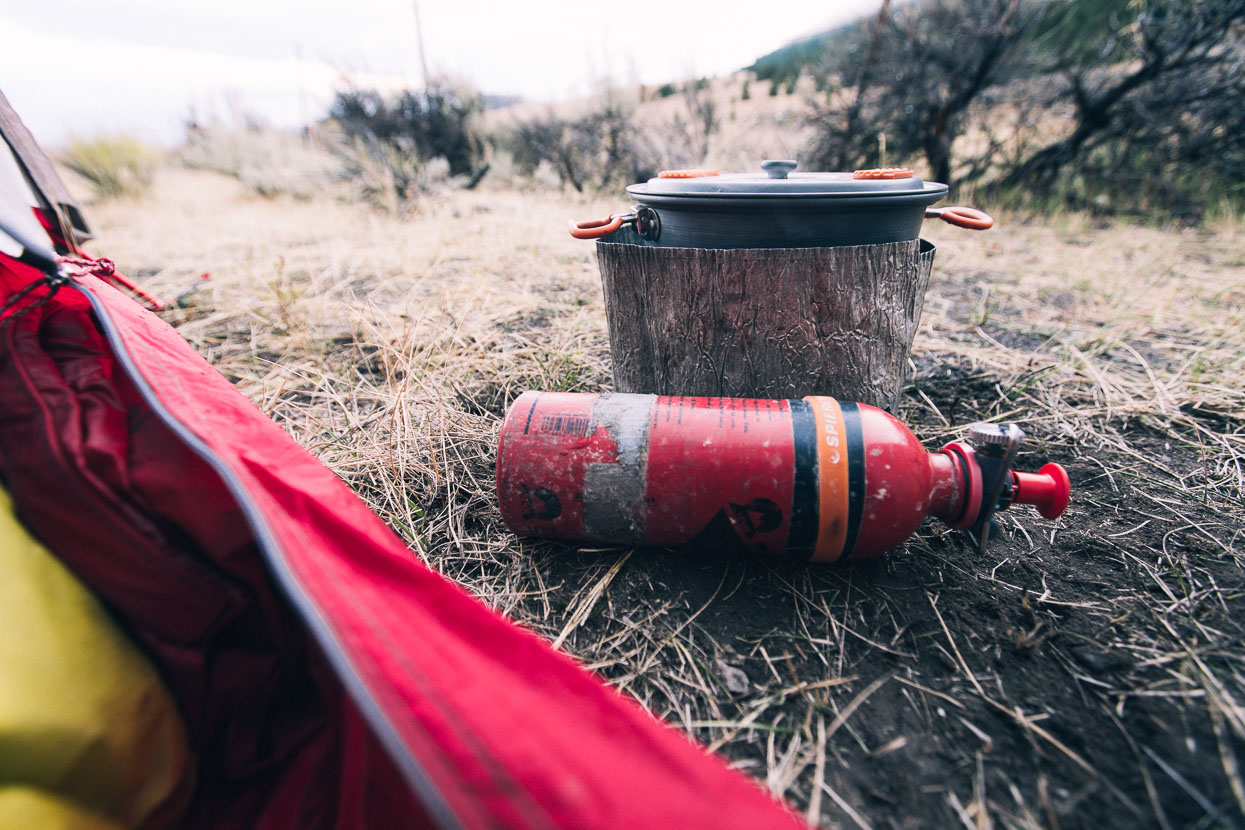
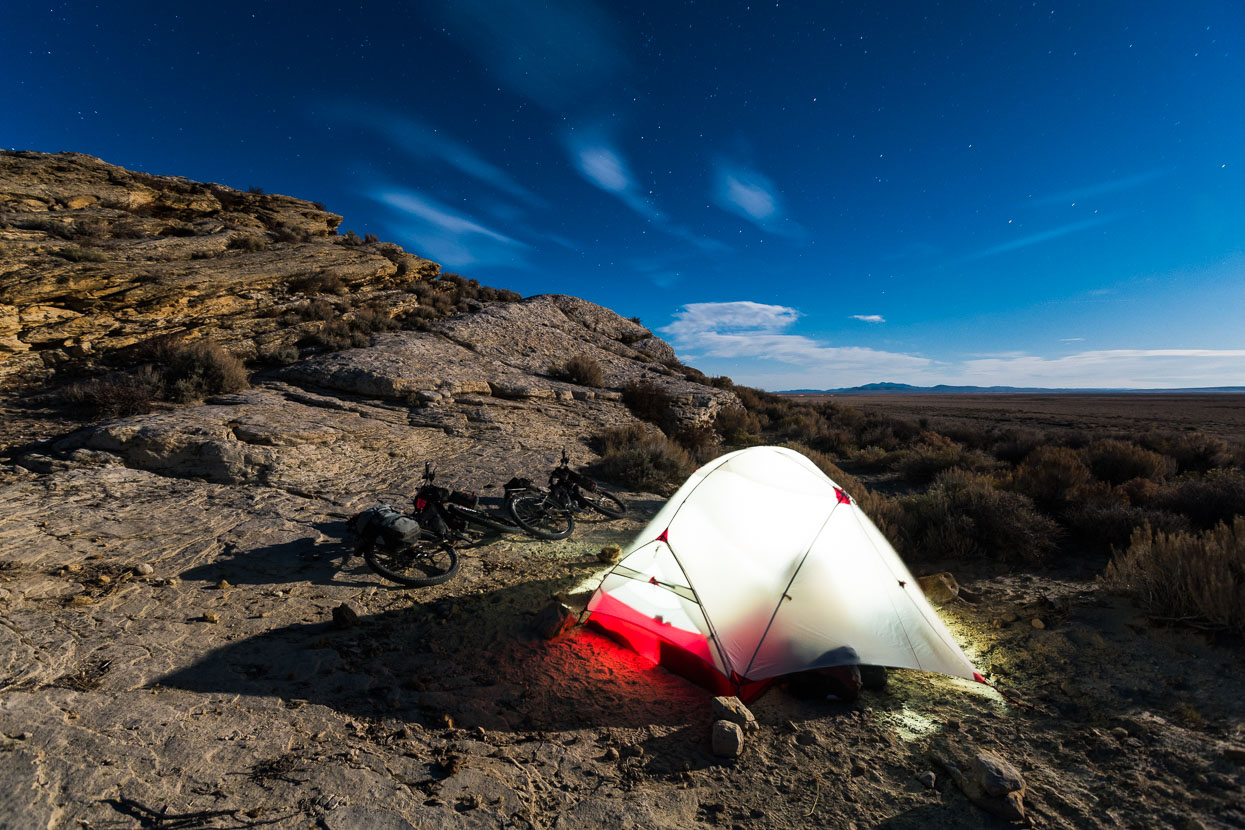
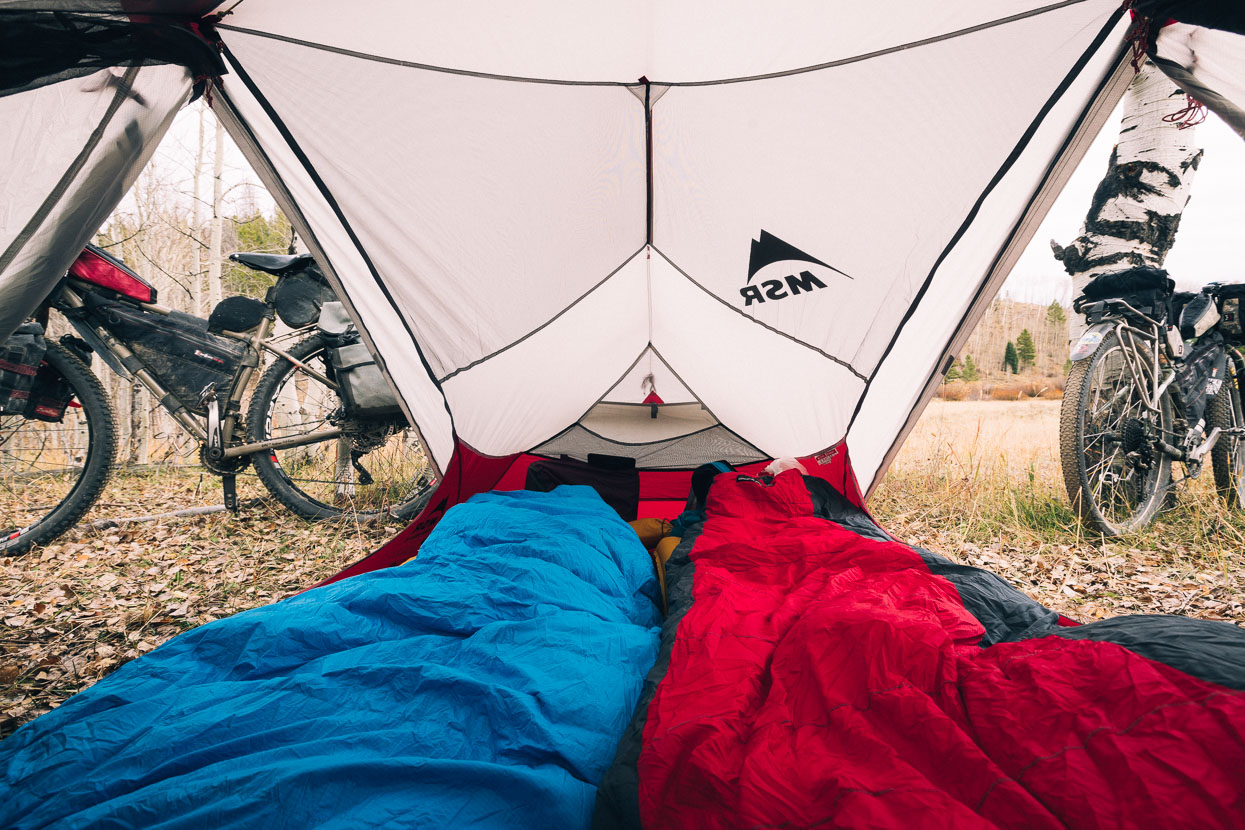
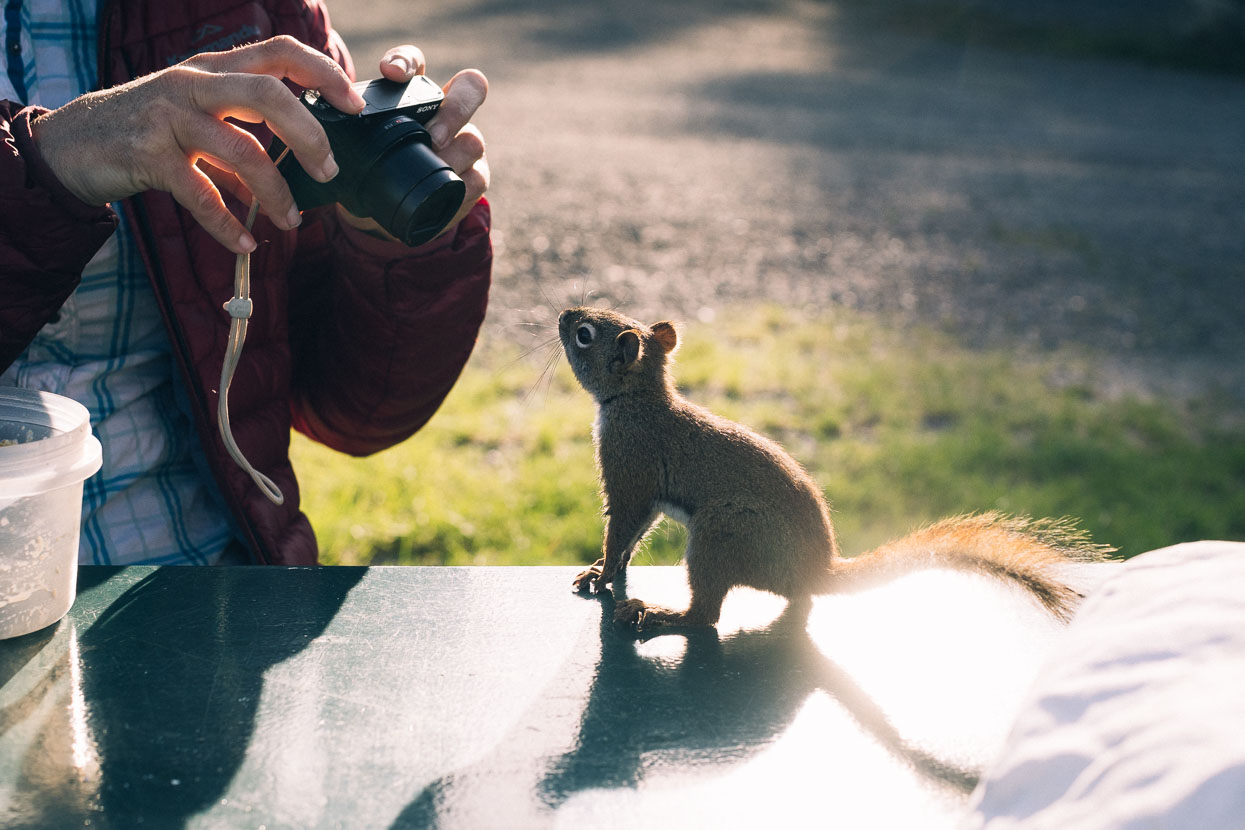
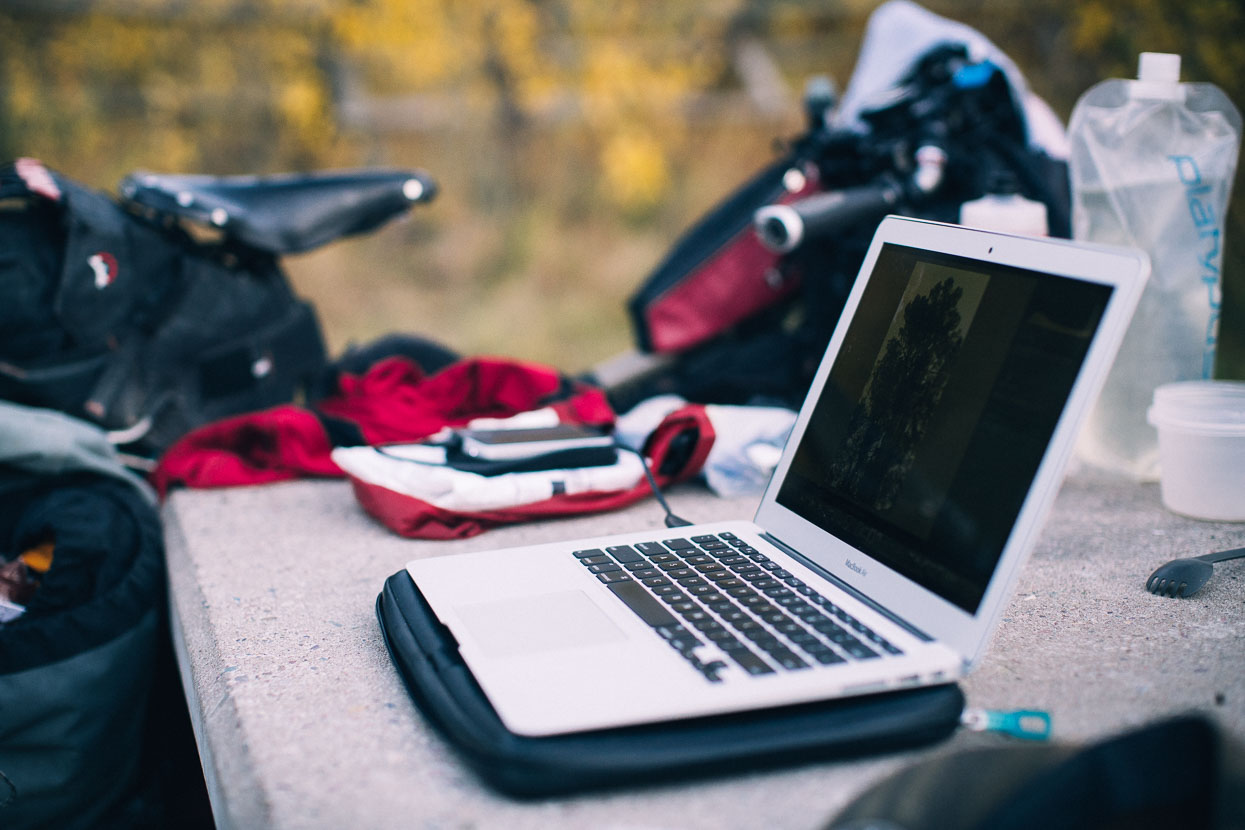
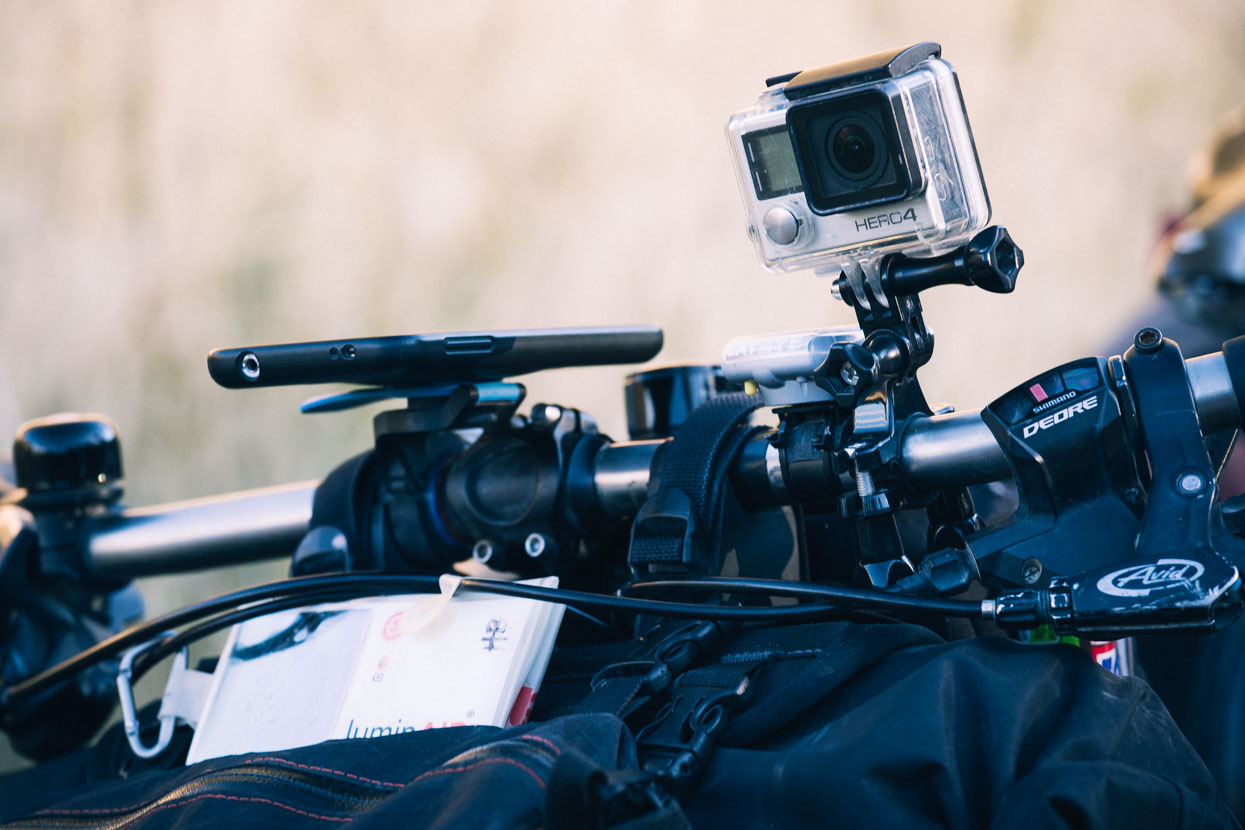
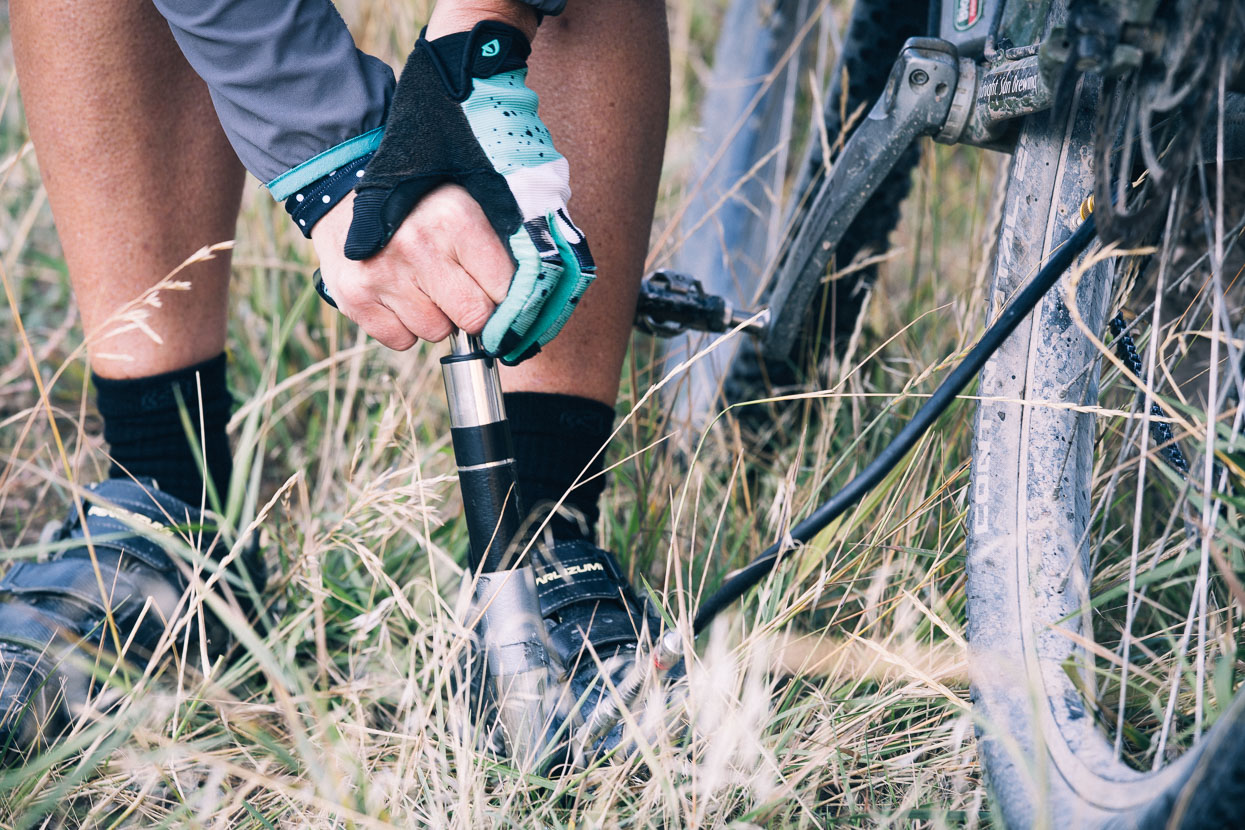

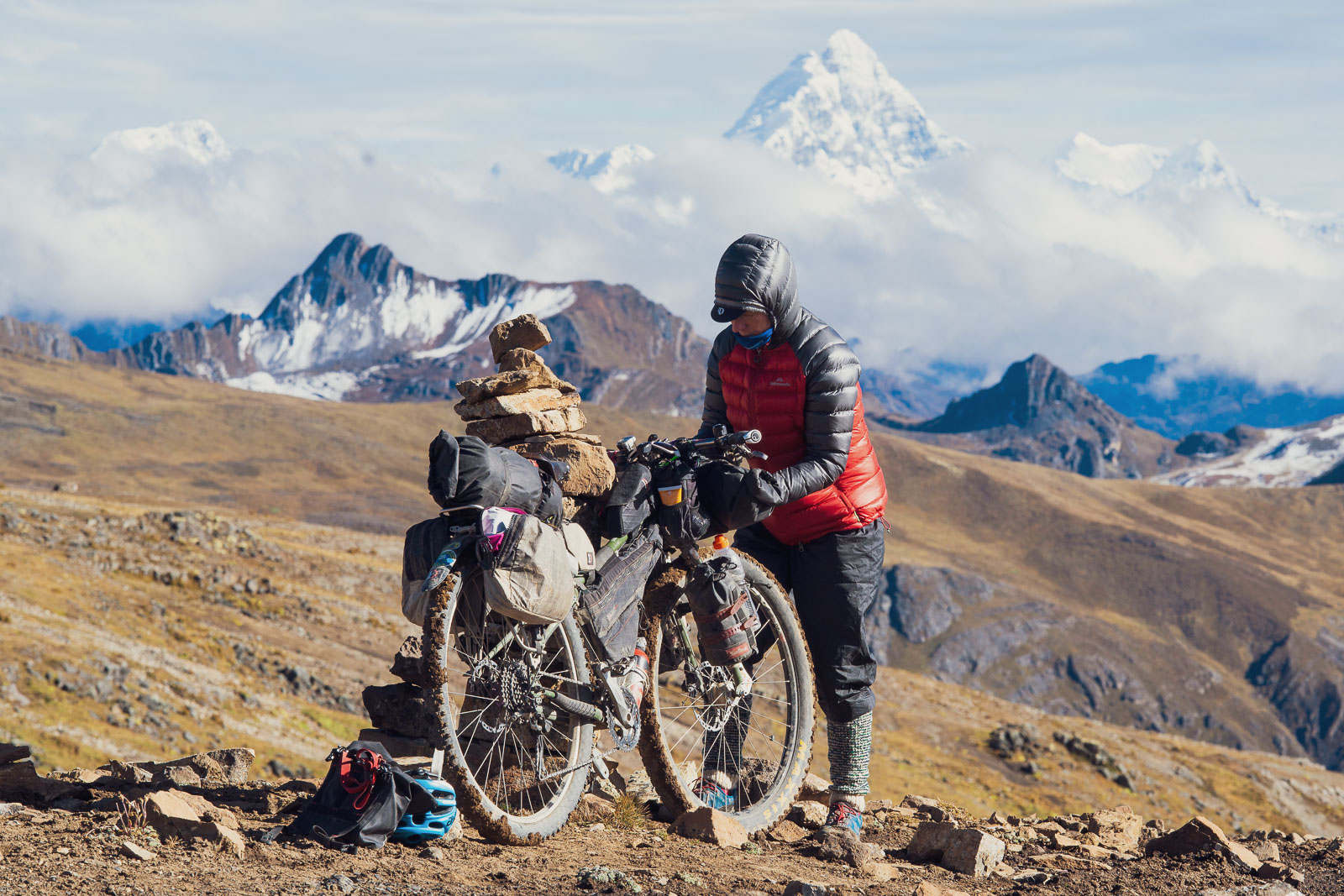
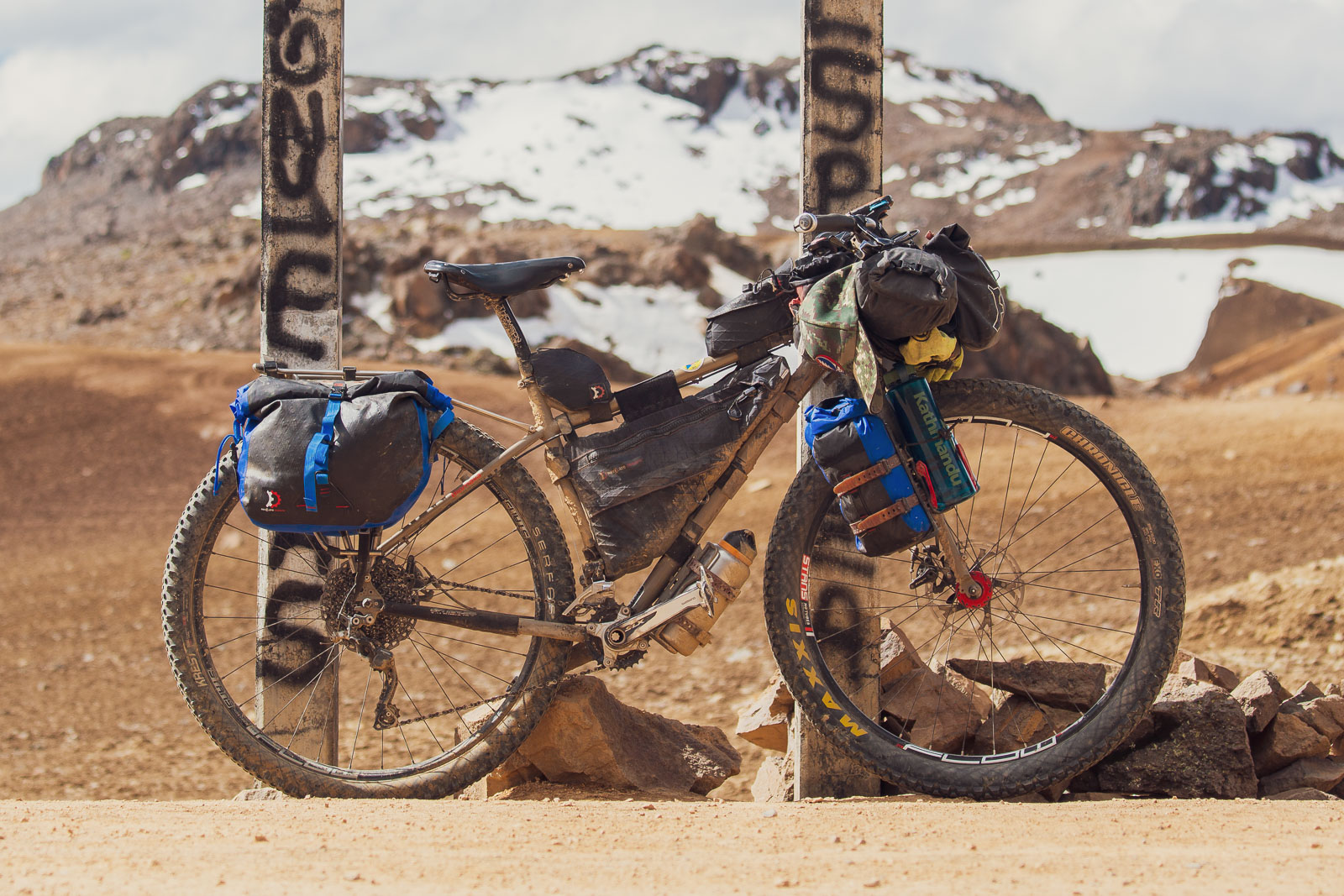





This is a very comprehensive and fantastic review. Not only have you provided the information but the reasons why you opted for that option when talking say, the tyres. Thank you, Leisa McNaughton
Thanks Leisa – glad you found it useful!
Hi Mark, you didn’t mention how you carry your camera gear 🙂
..And if the Ogre tire clearance is 2.5, how will you use 3″ tires for the Baja Divide?
Hi Daniele – 3.0 tyres fit fine on the front. We’ll be running 2.4 inch on the back for Baja.
Hi Daniele – “All camera gear except filters carried in Lowepro Flipside Sport 10L AW pack (an old model now)”. I carry the filters in an Adorama ‘Slinger’ case – in the bag on the front of my front roll (where they are handy).
Hope that helps.
Thanks for all the great info. Do you carry this camera gear on your back while riding or does this LowePro bag/pack slip into one of your rear panniers?
Thanks!
Charlie
No worries Charlie. When I had that pack I always wore it on my back. For the relatively dry run down through Canada and the US rockies it was fine, but once we got to Oaxaca I swapped it for a smaller Think Tank Turnstyle 5 sling bag, which holds just the body + 1 lens. I put my other two lenses into Think Tank Lens Changers and these go in my framebag. If it’s really wet I can put the sling pack in my pannier, or put in dry bag on the rack easily. It’s a great system for bigger cameras like mine, and it’s always handy.
Hi Team
Just wondering how you found your sleeping bags on the Great Divide. Did you use the Kathmandu or sea to summits? I’m planning on doing it in July/August so temperatures should be a bit more clement than you had. I’ve either got a really lightweight 200g fill bag tolerance +4C or a 750g fill -9 tolerance rating -9. I suspect I need something in between! Great trip you’re doing!
Thanks Alan. I reckon you’d be fine with the +3c bag at that time of the year. We’ve slept through a few frosts in the Kathmandu bags (same rating) and been ok, just. If you got a rare cold night you could always wear long johns and even a light down jkt if you had to. That said, I think frost would be rare that time of the year. The Great Divide maps have some useful climate graphs on them which helped us with such decisions. Were I doing it again in summer I’d definitely just use the KMD bag (Pathfinder). Cheers!
Hi Mark and Hana. Thank you for all of this valuable information. Could you tell us, of all of these items on your very comprehensive kit list, which would you both say are your top 3x favourites? -in terms of items that you feel have made the most difference to your comfort and/or survival while away from home and in the wilds for so long?
Thanks Andy!
My picks:
1. Watson Cycle Ti Revelation Handlebar (30 degree sweep) – the ti helps eliminate road shock and the sweep makes an anatomic position for the hands. I never wish I had bar ends now.
2. A worn-in Brooks Saddle – essential for a long trip.
3. Some form of entertainment/education – i.e. a Kindle and iPod, or music on your phone. We don’t listen to music often while riding, but it helps a lot on long/tedious sections or days when psyche is not so high.
Hana’s picks:
1. Podcasts and audible books (not just music) – it’s great to be learning stuff and to remain exposed to culture.
2. A good, thick, but light and compact sleeping mat (Exped UL7). It packs tiny but is thick enough for plushness.
3. Kathmandu LuminAID compact solar charged LED light. Very light, very compact and gives us enough light to cook and read by without head torches. Its diffuse glow makes any random campsite a temporary home and creates a sense of cosiness.
Hello
Really useful!
Thanks for the awesome post.
We’re also going to be cycling Alaska to Argentina via the great divide – starting in a couple of weeks – WAHOO!
The Ogre looks like a great bike for it but what are your thoughts on getting spare parts for a 29er in Latin America (we just dont know how available parts are).
Any top tips before we start?
Thanks guys
George and Kubes
Hi George, thanks – glad you enjoyed the content. We had a great time in northern AK and on Great Divide especially. Baja and rest of Mexcio been fantastic too.
Generally speaking I think the notion that 29er tyres will be scarce in Latin America is true, however these parts are much more common than they were a few years ago. I think with careful planning and a ‘bounce box’ we should be able to cover ourselves for tyres ok. Most likely we’ll carry one spare after Mexico too.
FedEx is much cheaper than in USA so it’s easy to send things ahead. I.e. we have sent parcels in Mexico twice and one to Huaraz, Peru.
Likewise if you do have a major blowout of tyre or rim, delivery of parts is possible to larger towns – with patience.
Hallo,
i saw that at the start of your trip you had some aerobars mounted.
Did you like them? Were they usefull? did you use them much?
We will be starting a cycling trip form Austria to SE-Asia in September. I was thinking about trying some aerobars, mostly for flat good roads, when its windy and to give the palms a break from time to time.
Greetings
Andi
Hi Andy – It was just Hana who had the aerobars, and yes she used them a fair bit, but only on pavement. We got rid of them in Canmore, before we started the Great Divide. But rather than to change to different position, they were more used in headwinds, long downhills and flats. We find our ti Watson Revelation bars so comfortable that we don’t really get hand problems. I’ve never even felt like I needed bar ends, which I have used in the past.
Good luck!
Hi Mark and Hana,
This is such a helpful page, and your trip and photos are really inspiring – especially as we are planning a similar trip for next year. I was wondering how you are finding the 29ers, and whether you think there is a minimum height a person should be before opting for 29 over 27.5? We want to swap our mainly-road touring set-ups for an off-road set-up that still allows us to carry enough to have a basic level of comfort since we’ll be out ‘on the road’ for around 18 months. And how have you found the heavily front-weight set-up? I found that with my previous set up with a heavily loaded Ortlieb bar-bag and front panniers on a Tubus swing rack (a high version that works on a suspension fork) it affected steering and also meant the front wheel was hard to stabilize when stopped. Lastly, are there any other aspects of the bike or gear set-up that you would say are the most crucial to ensure off-road riding is comfortable enough to remain fun?
Thanks!
Julie and Adam
Hi Julie and Adam – thanks – glad you find it useful!
Hana is 167 cm tall (5’5″) and I reckon that’s about the min height for 29ers. Shorter people would be better looking at 27.5 or even 26. But then you hit the tyre availability question which arises once you are south of Mexico. Basically 27.5 seems more common that 29 in Guatemala (and is most common in Mexico), but then in Honduras 29er seemed more common in the couple of bike shops we saw (though not in anything wider than 2.3). 26 inch is available in all the tiny non-specialist bike shops but they are low quality tyres.
So far we’re happy with our choice of 29er. At the moment we are running 3 inch front and 2.4 rear. We didn’t originally intend to run such a big tyre on front but after the Baja Divide we got hooked on big tyres! Because we don’t use suspension we like the bigger rubber up front.
Were I to start this trip again tomorrow, I’d probably ride a 27.5+.
Regarding the load on the bikes – the set up is designed to avoid the ‘heavily loaded’ front you mention by distributing the weight more or less evenly over the bikes, that said, the rear of the bikes is a tad heavier than the front, we find it perfect for handling on windy roads and technical riding. Nothing I’d change there.
Hope that helps!
Mark and Hana.
Hey, I see you guys are now using some Revelate Design Egress Pockets. Just wondering how you are liking them? I’m looking at getting one for my trip heading north from Ushuaia in January.
We love them – the 100% waterproofing is perfect in wet season Central America and they work great off-bike too as a shoulder bag/camera bag.
Great to hear. I ended up ordering one when they had a sale recently, I think it will be just what I need.
Cheers, maybe we’ll meet on the road in South America.
Kai
Hi Mark and Hanna. I’m seeking your advice on handlebars for my ride following your Peru-Ecuador route. For my previous long bikepack rides (tour divide, aotearoa) I’ve used a flat mtb bar (with ergon gp3 grips) with aero bars (for comfort, wind resistance and mounting light and gps). Thinking of switching to bar with sweep like your Watson Revelation for shoulder and wrist comfort. Do you think aero bars would be useful along your Ecuador-Peru route for comfort and wind resistance?
Hi Greg, We definitely recommend the swept-back bar like the Watson Revelation, but not too swept back like the Jones bars. The former is a better balance between comfort and still being suitable for technical riding. Jones Bars are a bit extreme in their angle, in my opinion. I would not bother with an aerobar though. In Ecuador and Peru 80% of your time is spent either climbing, or coasting downhill, so not much use… With the Revelation bar I have never once in 2.5 years wished for a bar-end or an alt hand position – they are that good.
Hello Mark and Hanna!
So, I’m building my first touring bike and am stumped, to say the least. As a shorter rider, (5′-7″), I initially gravitated towards the Surly Troll, but opted to look closer at the Ogre. After getting myself on a size small, shod with Maxxis 29×2.35 Ikon tires, the standover felt, well,…a bit on the uncomftable side to say the least (30″ inseam, so, it’s ok, but not real comfy.)
This leads to to ask you both, what size Ogres are you riding, and what do your inseams measure? (trying to get a better understanding and picture of where I’m at vs. other riders)
PS,.. your adventures are inspiring, very inspiring to say the least!!!
Thanks Jason! Here’s our numbers:
Hana 5’5 3/4″
Inseam 30.5″,
Ogre is a Small/16″ frame, with 170mm cranks, Stem 75mm with 10 deg rise.
Mark 5’10”
Inseam 33″,
Ogre is a Med/17″ frame, with 175mm cranks, Stem 85mm with 10 deg rise.
Both our bikes are more or less a perfect fit, but for really technical riding Hana finds 29 inch too big. Being a tad shorter in the inseam, looking at a 27.5 bike might be the way to go for you – a happy medium between rolling efficiency and handling.
HI,
Great setup. I’m interested how do you carry the mac ? I am tossing up iPad / mac at the moment – while I would love to have the mac capabilities with me I’m not sure about the weight / size and the iPad tools are ALMOST there (for some things)
You don’t seem to have any high panders – where do you carry it, are you worried about vibration ?
Unfortunately no one carries the Egress in my city so I need to order one, but they seem like they should be a perfect size for an iPad + camera ? (Oly m4/3s with a couple of lenses so not too big).
Thanks for the interesting article.
Hi Colin. Yes – always a dilemma re the laptop vs tablet but for me, the ability to easily copy and backup images to various drives was important. As well as more screen for processing and editing. I carry it in inside a Thule sleeve, inside my pannier. For extra protection, it’s also inside a sandwich of silver coated bubble wrap (the insulation kind). This doubles as my extra padding/protection for sleeping and sitting in camp. Helps stop my mat puncturing.
Does an iPad fit inside a Revelate Designs Egress Pocket?
Thanks
I’m not sure sorry. Probably… but you should check the specs on http://www.revelatedesigns.com